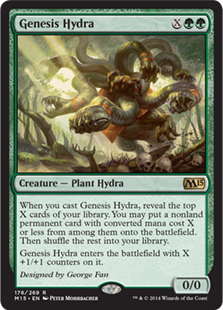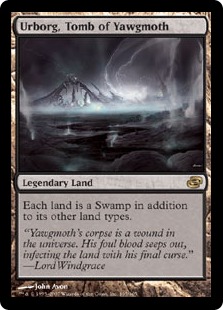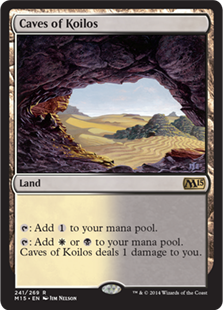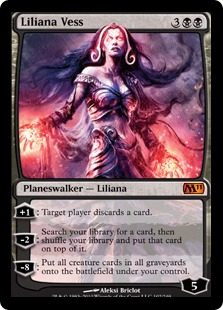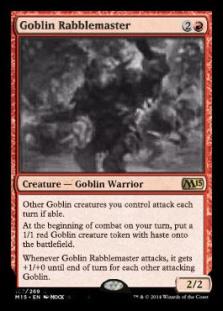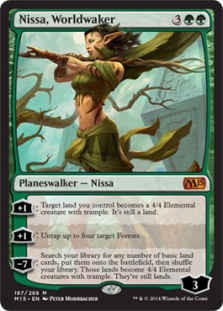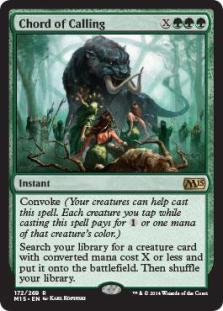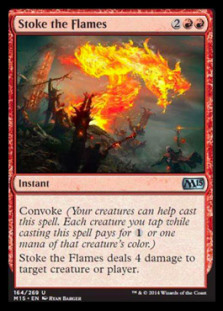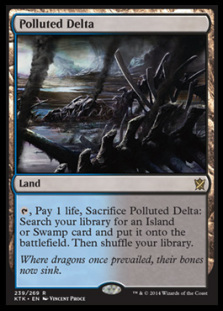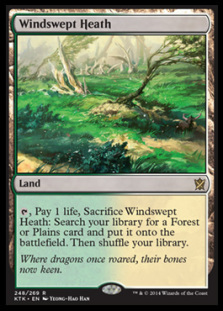This week I will be covering my renewed interest in Standard. As some of you know, I have been avoiding playing Standard until rotation happens and Khans of Tarkir replaces Return to Ravnica and M14. I have mono-blue devotion built, because I built it right after Pro Tour Dublin. But I was very bored with the deck and the metagame. You’ve heard me talk a bit about modern and my tribulations with Birthing Pod. But now, with a fresh format imminent, my desire to brew with new cards and tackle Standard has me inspired!
Well, it’s not entirely fresh. We have some data we can use as source material for how the incoming format will initially take shape, in Pro Tour Journey into Nyx and Grand Prix Manchester top performing decklists. If Theros Block Constructed will give us our starting point, then let’s analyze how we can best approach the format.
I believe the logical entry point for post-rotation deckbuilding is considering decklists that contain the Sylvan Caryatid / Courser of Kruphix engine. There were 28 copies of both Courser and Caryatid in the Pro Tour top 8 decks, and 20 copies of each at Grand Prix Manchester. The reason? Sylvan Caryatid serves as optimal mana fixing as well as providing an early blocker, one of your best turn-two plays against aggressive strategies, and certainly the best turn-two play against every other deck. It is akin to casting Farseek in Jund before Innistrad Block rotated out of standard.
As for Courser of Kruphix, this big butt centaur has quickly risen in regard to being considered the backbone of Standard’s future, and when considering deckbuilding one must take Courser of Kruphix into account. In my opinion, you are either with Courser and Caryatid, or against them, and your deck choice and building going forward should reflect this decision. So regardless of your opinion on these two cards, we must respect them.
Me, I side with them. It’s hard to refute the defensive nature of both cards, especially on curve. And the card advantage Courser of Kruphix provides has no parallel in the current standard card pool. Let’s now look over some winning decklists from the aforementioned Theros Block tournaments!
Sultai (BUG) Control by Jamie Parke
| Creatures (14) 4 Prognostic Sphinx 4 Courser of Kruphix 4 Sylvan Caryatid 2 Reaper of the Wilds Spells (20) 1 Bile Blight 1 Dissolve 3 Drown in Sorrow 4 Hero’s Downfall 1 Psychic Intrusion 2 Read the Bones 4 Silence the Believers 1 Unravel the Aether 3 Kiora, the Crashing Wave | Lands (26) 5 Forest 1 Island 2 Mana Confluence 6 Swamp 4 Temple of Deceit 4 Temple of Malady 4 Temple of Mystery Sideboard (15) 1 Agent of Erebos 3 Ashiok, Nightmare Weaver 1 Bile Blight 1 Dissolve 1 Drown in Sorrow 2 Feast of Dreams 1 Psychic Intrusion 3 Thoughtseize 2 Unravel the Aether |
Of the BUG control lists, between Team Channel Fireball and The Pantheon, I really liked the list Jamie Parke and Reid Duke ran in the top 8 of the Pro Tour. The decision to keep Thoughtseize in the board and run multiple main deck copies of Drown in Sorrow showed a respect for aggressive decks that Josh Utter-Leyton’s list kept in the sideboard, which gave Jamie and Reid the game one edge needed to weather the control decks slower draws. You’re not going to get to sequence a turn 2 Sylvan Caryatid, turn 3 Courser of Kruphix every game, and this list acknowledges that. I also like Drown in Sorrow as an answer to Constellation decks, as it sweeps Brain Maggot and Eidolon of Blossoms.
Last, but certainyl not least, is the synergy between Kiora, the Crashing Wave, and Courser of Kruphix. Kiora’s -1 ability can dig up to an additional two cards per turn with an active Courser, and her +1 ability provides defense when behind on the board. Her ultimate is very threatening, providing you with inevitability as an endless stream of 9/9 krakens! The team of Caryatid, Courser, and Kiora is very powerful, in that it provides real card advantage, a defensive shield, and ramps the control player into casting it’s more mana intensive spells. The incidental life gain and playability off the top of your library are small but incremental pieces of advantage a competent pilot can leverage into victories.
Which is why, when observing Patrick Chapin’s winning decklist, his card choices make a lot of sense. Particularly his creature base. He knew, going into the tournament, that Courser of Kruphix and Sylvan Caryatid were going to be major elements of the metagame, and chose creatures that were not only threatening to Caryatid and Courser, but would also get under Elspeth, Sun’s Champion (the other mainstay of the format) effectively. Fleecemane Lion and Brimaz, King of Oreskos could punch through defenses, are each very resilient threats, and they can both block well if behind on the board!
Most important, however, was that Chapin also harnessed the power of Sylvan Caryatid and Courser of Kruphix in his deck! So, on top of threatening his opponents who cast them, he also knew enough to utilize them himself. Let’s take a look at his decklist:
Abzan (Junk) Midrange by Patrick Chapin
| Creatures (18) 4 Brimaz, King of Oreskos 4 Fleecemane Lion 4 Courser of Kruphix 4 Sylvan Caryatid 2 Polukranos, World Eater Spells (17) 1 Banishing Light 4 Hero’s Downfall 1 Read the Bones 4 Silence the Believers 3 Thoughtseize 4 Elspeth, Sun’s Champion | Lands (25) 4 Forest 4 Mana Confluence 2 Plains 3 Swamp 4 Temple of Malady 4 Temple of Silence 4 Temple of Plenty Sideboard (15) 2 Arbor Colossus 1 Bile Blight 2 Boon Satyr 2 Deicide 2 Drown in Sorrow 1 Feast of Dreams 2 Glare of Heresy 1 God’s Willing 1 Read the Bones 1 Thoughtseize |
Instead of a control deck, Chapin’s deck plays a true midrange strategy, where each threat cast requires an answer before it threatens to take over the board. It’s arguably simpler than the Sultai control deck, in part because Chapin got to focus on turning dudes sideways (or not, thanks to Brimaz) and, overall, his deck was asking questions instead of providing answers.
So here we have two different builds that utilize the power of Sylvan Caryatid and Courser of Kruphix. These two decks have been my starting point for my initial delve (spoilers!) into standard. But, there’s more to Standard than Theros Block. We have M15 to look at, and of course, what we know so far of Khans of Tarkir. So, keeping these decks in mind, let’s look at the M15 cards that have made crashes in the current standard field.
Urborg and enemy colored painlands have been such a welcome addition to a format that is about to lose it’s shock lands. The green spells, Nissa, Worldwaker, Chord of Calling, and Genesis Hydra, all seem packaged together for the same strategy, big green. While Nissa is a very powerful planeswalker, she asks our deck to be mostly forests to get full value from her abilities. Liliana Vess has seen some play in black devotion decks, and Orzhov midrange, but it didn’t reinvent the wheel.
Goblin Rabblemaster and Stoke the Flames, however, have given red decks fantastic tools to generate board advantage and provide reach. Stoke the Flames is also a great answer to Courser of Kruphix. These cards have been tearing up the current Standard metagame. Whether or not Rabblemaster will retain it’s power post-rotation is to be seen, but odds are they will continue to be major players in the coming months for aggressive strategies.
But we are not here to evaluate Rabblemaster. We have to make sure our build can beat him, but we are not looking to play him.
The major inclusions from M15 that could be added to the Courser of Kruphix / Sylvan Caryatid decks are looked at two different ways. One can go mono-green, or close to it, and add the heavy hitters from M15. But I am hesitant to get behind that strategy the more I look at Khans of Tarkir. Khans wants me to play multi-color decks to take full advantage of the new wedge cards. And our Theros Block Constructed decklists happen to be in two of the wedges supported by Khans of Tarkir! Bug is now Sultai, and Junk is now Abzan. We have all these fun tools at our disposal to brew with, and I would rather dedicate my time to expanding Sultai and Junk than run away from the wedges by playing a more mono-colored deck.
What is the card I am most excited to include into these lists?
Fetch lands. Wow. Not only am I excited to be fetching in standard, but given that we are looking to build on the Couser of Kruphix strategy, the fetch lands become very valuable to our decks ability to smooth out a mana base, and in the context of the Sultai control deck, utilize Kiora and Courser to increase our card selection, thereby maximizing the value of the fetch land.
In goldfishing my initial Sultai list, the following sequence that came up on turn 5. My board has Sylvan Caryatid, Kiora, the Crashing Wave and Courser of Kruphix.
Draw card for turn. Courser reveals Polluted Delta. Play Polluted Delta off the top of my library and gain 1 life. Courser reveals a spell. Minus Kiora to draw a card. Courser reveals an irrelevant spell. Crack Polluted Delta for a swamp and gain 1 life. Courser reveals Temple of Mystery. Play Temple off the top of my library and gain 1 life. Courser reveals Llanowar Wastes. Scry to the bottom of my library. Courser reveals another Kiora.
This turn, before casting my first spell, I was able to manipulate my library five cards deeper, gain three life, and anticipate an excellent draw step for my next turn. While most of these interactions are currently available in the Theros Block list, the addition of the Polluted Delta allowed me to see a fresh card off the top of my library with an active Courser of Kruphix. This quality of library manipulation is powerful and went over the top thanks to the presence of the Polluted Delta.
Having fetch lands also provides a three color deck with a smoother mana base, lessening the reliance on Mana Confluence, mitigating life loss and, to a slight degree, thins out the deck.
As for incorporating new cards from Khans of Tarkir, i’ve had a lot of fun experimenting with some ideas as they are spoiled. Here are some sample decklists, starting with my current Sultai control prototype:
Sultai Control
Negate, Sultai Charm, and Ashiok, Nightmare Weaver are all flexible slots, but I like the idea of Sultai Charm replacing Read the Bones, Negate replacing Dissolve, and Ashiok, Nightmare Weaver in anticipation of the mirror match, as well as cutting one land.
Lastly, here is the Abzan deck, a list I have not solidified in my mind yet, and as such is changing every day.
Abzan Midrange
| Creatures (22) 4 Sylvan Caryatid 4 Courser of Kruphix 4 Fleecemane Lion 4 Brimaz, King of Oreskos 3 Anafenza, the Foremost 3 Seige Rhino Spells (14) 4 Hero’s Downfall 2 Utter End 3 Silence the Believers 4 Thoughtseize 1 Read the Bones | Lands (24) 4 Windswept Heath 4 Temple of Malady 4 Temple of Silence 4 Caves of Koilos 4 Llanowar Wastes 3 Forest 1 Plains Sideboard (15) 2 Sorin, Solemn Visitor 2 Feast of Dreams 2 Drown in Sorrow 2 Bile Blight 3 Abzan Ascendancy 4 Elspeth, Sun’s Champion |
The strategy is essentially the same as Chapin’s list, updated with the awesome Siege Rhino and Anafenza, the Foremost as aggressively costed threats. Having them in the deck lowers the value of Elspeth, Sun’s Champion, so it’s been moved to the sideboard against control matchups. Not knowing what Abzan Charm does leaves a big question mark. But Abzan Ascendancy seems like a possible sideboard card against sweepers.
Well, that’s all for this week. Next week I hope to have seen enough (or all) of Khans of Tarkir spoilers so I can really get going on moving Courser of Kruphix forward. But for now, it seems that beginning with him is the best place to start.
After a ten-year lapse from Magic, where his favorite combo was Tradewind Rider with Stasis, Derek is back to learn the new-border variant of the game. While less frustrating cards have been printed, he now has to get used to planeswalkers, and people rolling dice when he resolves Hymn to Tourach. He qualified for the Junior Super Series in 1999 at Pro Tour New York, then used his collection to finance his college education. Years later, he works in the fashion industry as a stylist, consultant, and sometime-matchmaker for brands. He loves all things black leather, and is out to journal his level-ups with hopes of playing at the highest competitive level of the game. You can reach him at derek.gallen@gmail.com.


